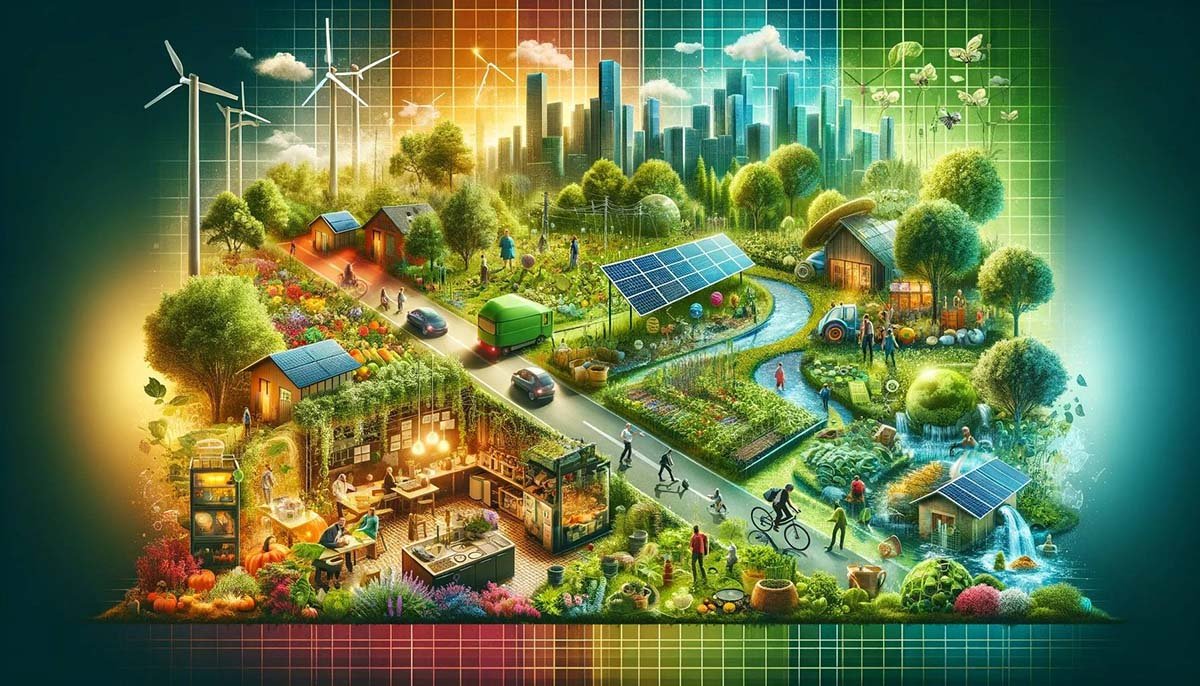Living sustainably isn’t just a trend; it’s a lifestyle that harmonizes our existence with the environment, fostering a healthier planet for current and future generations. Sustainable living encompasses a holistic approach, integrating principles that promote ecological balance, social responsibility, and economic viability.
Understanding Sustainable Living
Sustainable living revolves around conscientious choices that minimize our impact on the planet while maximizing resource efficiency. It’s a mindset, a commitment to adopt practices that promote environmental preservation, social equity, and economic stability. Here are the seven principles of sustainable living that can guide and inspire individuals towards a more harmonious existence:
1. Reduce, Reuse, Recycle
The mantra of “reduce, reuse, recycle” encapsulates the essence of minimizing waste. Reducing involves cutting down on unnecessary consumption, whether it’s avoiding single-use plastics, buying only what’s needed, or opting for products with minimal packaging. Reusing encourages finding multiple purposes for items, like repurposing containers or donating clothing. Recycling involves properly disposing of materials that can be transformed into new products, reducing the strain on natural resources. Understanding the lifecycle of products plays a pivotal role in implementing this principle effectively. Choosing products labeled as biodegradable or recyclable contributes significantly to reducing environmental impact.
2. Energy Conservation
Saving energy not only reduces utility bills but also benefits the environment. Adopting energy-efficient practices, such as using energy-saving appliances, turning off lights when not in use, and insulating homes, helps cut down on energy consumption. Investing in renewable energy sources, like solar panels or wind turbines, offers sustainable alternatives to fossil fuels. Understanding the importance of reducing our carbon footprint and embracing eco-friendly energy options is crucial in implementing this principle.
3. Sustainable Food Choices
Making conscious decisions about food consumption greatly impacts sustainability. Supporting local farmers by purchasing seasonal produce not only reduces carbon emissions from transportation but also supports the local economy. Opting for organic produce reduces exposure to pesticides and supports farming practices that prioritize soil health. Additionally, reducing meat consumption or choosing sustainably sourced meat and seafood minimizes the environmental impact of our diets. Furthermore, minimizing food waste by practicing proper storage techniques, composting organic waste, and utilizing leftovers aligns with this principle, contributing to a more sustainable food cycle.
4. Water Conservation
Conserving water is essential to ensure this finite resource remains available for future generations. Simple practices, such as fixing leaks, installing water-saving devices like low-flow showerheads and faucets, and collecting rainwater for gardening, significantly reduce water usage. Being mindful of water consumption during daily activities, such as washing dishes or watering plants, helps in preserving this vital resource. Awareness about water scarcity and the importance of its conservation is crucial in implementing this principle.
5. Biodiversity Preservation
Protecting biodiversity involves safeguarding ecosystems and the species within them. Supporting ecosystem restoration initiatives, like reforestation or wetland conservation projects, helps maintain the balance of natural habitats. Avoiding the use of harmful chemicals, pesticides, and fertilizers contributes to preserving wildlife and ecosystems. Embracing permaculture practices, which focus on sustainable land use and regenerative agriculture, fosters diverse and resilient ecosystems. Understanding the interconnectedness of all living organisms and the role they play in the ecosystem is fundamental in preserving biodiversity.
6. Conscious Consumerism
Being mindful of the products we buy and the companies we support significantly impacts sustainability. Considering the lifecycle of products before purchasing, opting for items that are durable, repairable, or made from recycled materials reduces waste. Choosing fair trade goods ensures fair wages and ethical production practices, promoting social and environmental sustainability. Supporting environmentally conscious brands that prioritize sustainability in their operations encourages a shift towards more eco-friendly consumer habits. Moreover, being aware of the environmental and social impact of our purchases is crucial in adopting this principle.
7. Environmental Education and Advocacy
Educating oneself and others about sustainability is pivotal in driving positive change. Accessing reliable resources, attending workshops, or taking courses that delve into environmental issues equips individuals with the knowledge needed to make informed decisions. Sharing information and advocating for sustainable practices within communities, workplaces, and policymaking encourages collective action towards a more sustainable future. Engaging in environmental advocacy initiatives, such as participating in rallies, signing petitions, or supporting legislation that promotes sustainability, amplifies the impact of individual efforts.
Implementing Sustainable Living: A Step-by-Step Guide
1. Start Small
Initiate your sustainable living journey by making small changes. Use a reusable water bottle, carry a cloth bag for shopping, or begin composting food scraps. Small steps can lead to significant impacts when practiced consistently.
2. Educate Yourself
Dive deeper into sustainability by exploring reputable sources and educational platforms. Understanding the implications of your actions on the environment empowers you to make more conscious choices.
3. Evaluate Your Lifestyle
Reflect on your daily habits and identify areas where improvements can be made. Whether it’s reducing energy usage, minimizing waste, or supporting ethical brands, recognizing areas for change is the first step towards transformation.
4. Set Goals
Establish achievable and measurable goals to gradually transition to a more sustainable lifestyle. Whether it’s reducing household waste or supporting local businesses, setting specific targets provides direction and motivation.
5. Engage with Community
Join local sustainability groups, attend workshops, or participate in community projects. Connecting with like-minded individuals creates a supportive environment and fosters the exchange of ideas and experiences.
6. Advocate for Change
Use your voice to raise awareness and advocate for sustainable practices. Engaging in discussions, sharing knowledge, and encouraging others to adopt sustainable habits amplifies the collective impact towards a more sustainable society.
Conclusion
Embracing the principles of sustainable living isn’t just a lifestyle choice; it’s a responsibility towards the planet and future generations. By incorporating these principles into our daily lives and taking actionable steps, we contribute to a healthier and more sustainable world.
Sustainable living is an ongoing journey that requires commitment and continuous effort. Every individual action, no matter how small, contributes to the greater goal of ensuring a thriving planet for generations to come.

